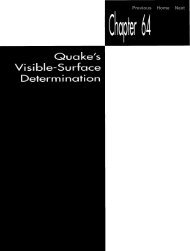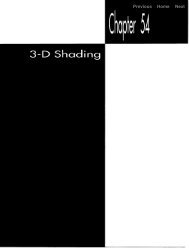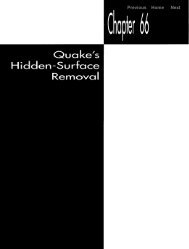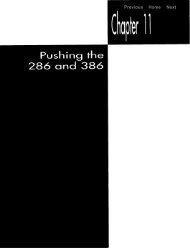sneakers in space
sneakers in space
sneakers in space
You also want an ePaper? Increase the reach of your titles
YUMPU automatically turns print PDFs into web optimized ePapers that Google loves.
about a bit. You’ll be busy view<strong>in</strong>g the asteroids <strong>in</strong> their primary role, as objects to be<br />
navigated around, and the mere presence of topographic detail will suffice; without<br />
be<strong>in</strong>g aware of it, you’ll fill <strong>in</strong> the blanks. Your m<strong>in</strong>d will see the topography peripherally,<br />
recognize it for what it is supposed to be, and, unless the landscape does<br />
someth<strong>in</strong>g really obtrusive such as vanish<strong>in</strong>g altogether or suddenly shoot<strong>in</strong>g spike a<br />
miles <strong>in</strong>to <strong>space</strong>, you will see what you expect to see: a bunch of nicely detailed<br />
asteroids tumbl<strong>in</strong>g around you.<br />
To what extent can you rely on the eye and m<strong>in</strong>d to make up for imperfections <strong>in</strong> the<br />
3-D animation process? In some areas, hardly at all; for example, jaggies crawl<strong>in</strong>g<br />
along edges stick out like red flags, and likewise for flicker. In other areas, though,<br />
the human perceptual system is more forgiv<strong>in</strong>g than you’d th<strong>in</strong>k. Consider this: At<br />
the end of Return of the Jedi, <strong>in</strong> the battle to end all battles around the Death Star,<br />
there is a sequence of about five seconds <strong>in</strong> which several <strong>space</strong>ships are visible <strong>in</strong><br />
the background. One of those <strong>space</strong>ships (and it’s not very far <strong>in</strong> the background,<br />
either) looks a bit unusual. What it looks like is a sneaker. In fact, it is a sneaker-but<br />
unless you know to look for it, you’ll never notice it, because your m<strong>in</strong>d is busy<br />
mak<strong>in</strong>g simplifylng assumptions about the complex scene it’s see<strong>in</strong>g-and one of<br />
those assumptions is that medium-sized objects float<strong>in</strong>g <strong>in</strong> <strong>space</strong> are <strong>space</strong>ships, unless<br />
proven otherwise. (Thanks to Chris Hecker for po<strong>in</strong>t<strong>in</strong>g this out. I’d never have noticed<br />
the sneaker, myself, without be<strong>in</strong>g tipped off-which is, of course, the whole po<strong>in</strong>t.)<br />
If it’s good enough for George Lucas, it’s good enough for us. And with that, let’s<br />
resume our quest for realtime 3-D animation on the PC.<br />
One-sided Polygons: Backface Removal<br />
In the previous chapter, we implemented the basic polygon draw<strong>in</strong>g pipel<strong>in</strong>e, transform<strong>in</strong>g<br />
a polygon all the way from its basic def<strong>in</strong>ition <strong>in</strong> object <strong>space</strong>, through the<br />
shared 3-D world <strong>space</strong>, and <strong>in</strong>to the 3-D <strong>space</strong> as seen from the viewpo<strong>in</strong>t, called<br />
vim <strong>space</strong>. From view <strong>space</strong>, we performed a perspective projection to convert the<br />
polygon <strong>in</strong>to screen <strong>space</strong>, then mapped the transformed and projected vertices to<br />
the nearest screen coord<strong>in</strong>ates and filled the polygon. Armed with code that implemented<br />
this pipel<strong>in</strong>e, we were able to watch as a polygon rotated about its Y axis, and<br />
were able to move the polygon around <strong>in</strong> <strong>space</strong> freely.<br />
One of the drawbacks of the previous chapter’s approach was that the polygon had<br />
two visible sides. Why is that a drawback? It isn’t, necessarily, but <strong>in</strong> our case we want<br />
to use polygons to build solid objects with cont<strong>in</strong>uous surfaces, and <strong>in</strong> that context,<br />
only one side of a polygon is visible; the other side always faces the <strong>in</strong>side of the<br />
object, and can never be seen. It would save time and simplify the process of hidden<br />
surface removal if we could quickly and easily determ<strong>in</strong>e whether the <strong>in</strong>side or outside<br />
face of each polygon was fac<strong>in</strong>g us, so that we could draw each polygon only if it<br />
were visible (that is, had the outside face po<strong>in</strong>t<strong>in</strong>g toward the viewer). On average,<br />
half the polygons <strong>in</strong> an object could be <strong>in</strong>stantly rejected by a test of this sort. Such<br />
954 Chapter 51
















